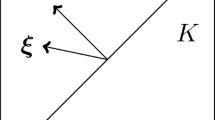Abstract
A fast multipole boundary element method (FMBEM) is presented for diffusion problems based on a dual reciprocity formulation. In the dual reciprocity formulation, domain integrals that arise from solving the time-dependent boundary value problems are transformed into boundary integrals by constructing particular solutions. The time-derivatives in the governing differential equation are approximated with a first-order finite difference time-stepping scheme. Discontinuous linear elements, which are known to give more accurate results than constant or linear elements, are used in the implementation to discretize the boundary integral equations, in combination with the fast multipole method for speeding up the solution. Three numerical examples of diffusion are presented. The performance of the developed FMBEM is compared with that of a conventional BEM and a commercial finite element program. The results show that the developed FMBEM can be a reliable and efficient tool for solving diffusion problems.


























Similar content being viewed by others
References
Ingber MS, Phan-Thien N (1992) A boundary element approach for parabolic differential equations using a class of particular solutions. Appl Math Model 16:124–132
Chang Y, Kang CS, Chen DJ (1973) The use of fundamental Green’s functions for the solution of problems of heat conduction in anisotropic media. Int J Heat Mass Transf 16:1905–1918
Shaw R (1974) An integral equation approach to diffusion. Int J Heat Mass Transf 17:693–699
Wrobel LC, Brebbia CA (1979) The boundary element method for steady-state and transient heat conduction. In: Lewis RW, Morgan K (eds) Numerical methods in thermal problems. Pineridge Press, Swansea
Costabel M (2004) Time-dependent problems with the boundary integral equation method. In: Stein E, de Borst R, Hughes TJR (eds) Encyclopedia of computational mechanics. Wiley, New Jersey
Rizzo F, Shippy DJA (1970) Method of solution for certain problems of transient heat conduction. AIAA J 8:2004–2009
Liggett JA, Liu PLF (1979) Unsteady flowin confined aquifers: a comparison of boundary integral methods. Water Resour Res 15:861–866
Taigbenu AE, Liggett JA (1985) Boundary element calculations of diffusion equation. J Eng Mech 111(3):311–328
Curran DAS, Cross M, Lewis BA (1980) A preliminary analysis of boundary element methods applied to parabolic partial differential equations. In: Brebbia CA (ed) New developments in boundary element methods. Computational Mechanics Publications, Southampton
Tanaka M, Matsumoto T, Yang QF (1994) Time-stepping boundary element method applied to 2-D transient heat conduction problems. Appl Math Model 18:569–576
Wrobel LC (2002) The boundary element method: applications in thermo-fluids and acoustics. Wiley, New Jersey
Patridge PW, Brebbia CA, Wrobel LC (1992) The dual reciprocity boundary element method. Computational Mechanics Publications, Southampton-Boston
Patridge PW (2000) Towards criteria for selecting approximation function in the dual reciprocity method. Eng Anal Bound Elem 24:519–529
Gaul L, Kogl M, Wagner M (2003) Boundary element method for engineers and scientists. Springer, Berlin
Greengard L, Rokhlin V (1997) A fast algorithm for particle simulations. J Comput Phys 135:280–292
Nishimura N (2002) Fast multipole accelerated boundary integral equation methods. Appl Mech Rev 55:299–324
Shen L, Liu YJ (2007) An adaptive fast multipole boundary element method for three-dimensional potential problems. Comput Mech 39(6):681–691
Liu YJ, Nishmura N, Otani Y, Takahashi T, Chen XL, Munakata H (2005) A fast boundary element method for the analysis of fiber-reinforced composites based on a rigid-inclusion model. J Appl Mech 72(1):115–128
Liu YJ (2006) A new fast multipole boundary element method for solving large-scale two-dimensional elastostatic problems. Int J Numer Methods Eng 65(6):863–881
Greengard L et al (1998) Accelerating fast multipole methods for the Helmholtz equation at low frequencies. IEEE Comput Sci Eng 5(3):32–38
Shen L, Liu YJ (2007) An adaptive fast multipole boundary element method for three-dimensional acoustic wave problems based on the Burton–Miller formulation. Comput Mech 40(3):461–472
Greengard LF, Kropinski MC, Mayo A (1996) Integral equation methods for Stokes flow and isotropic elasticity in the plane. J Comput Phys 125:403–414
Frangi A, Di Gioia A (2005) Multipole BEM for the evaluation of damping forces on MEMS. Comput Mech 37:24–31
Frangi A (2005) A fast multipole implementation of the qualocation mixed-velocity-traction approach for exterior Stokes flows. Eng Anal Bound Elem 29:1039–1046
Frangi A, Spinola G, Vigna B (2006) On the evaluation of damping in MEMS in the slip-flow regime. Int J Numer Methods Eng 68:1031–1051
Liu YJ (2008) A new fast multipole boundary element method for solving 2-D stokes flow problems based on a dual BIE formulation. Eng Anal Bound Elem 32(2):139–151
Ang W-T (2007) A begineer’s course in boundary element methods. Universal Publishers, Boca Raton
Liu YJ (2009) Fast multipole boundary element method: theory and applications in enineering. Cambridge University Press, Cambridgen
Milica R, William D, Robert L, Gordanna V (2005) Mathematical model of oxygen distribution in engineered cardiac tissue with parallel channel array perfused with culture medium containing oxygen carries. Am J Physiol Heart Circ Physiol 288:H1278–H1289
Wang B (2007) Microvascular transport model predicts oxygenation changes in the infarcted heart after treatment. Am J Physiol Heart Circ Physiol 293:H3723–H3739
Radisic M, Deen W, Langer R, Vunjak-Novakovic G (2005) Mathematical model of oxygen distribution in engineered cardiac tissue with parallel channel array perfused with culture medium containing oxygen carries. Am J Physiol Heart Circ Physiol 288:1278–1289
Reffelmann T, Dow JS, Dai W, Hale SL, Simkhovich BZ, Kloner RA (2003) Transplantation of neonatal cardiomyocytes after permanent coronary artery occlusion increases regional blood flow of infarcted myocardium. J Mol Cell Cardiol 35:607–613
Acknowledgments
The authors would like to thank Professor Whye-Teong Ang at Nanyang Technological University in Singapore and Professor Yijun Liu at the University of Cincinnati for their valuable discussions on the topic of DR-BEM and the fast multipole BEM.
Author information
Authors and Affiliations
Corresponding author
Rights and permissions
About this article
Cite this article
Wang, B., Chen, X. Fast multipole accelerated dual reciprocity boundary element method for diffusion problems. Ann. Solid Struct. Mech. 7, 45–58 (2015). https://doi.org/10.1007/s12356-015-0041-y
Received:
Accepted:
Published:
Issue Date:
DOI: https://doi.org/10.1007/s12356-015-0041-y




